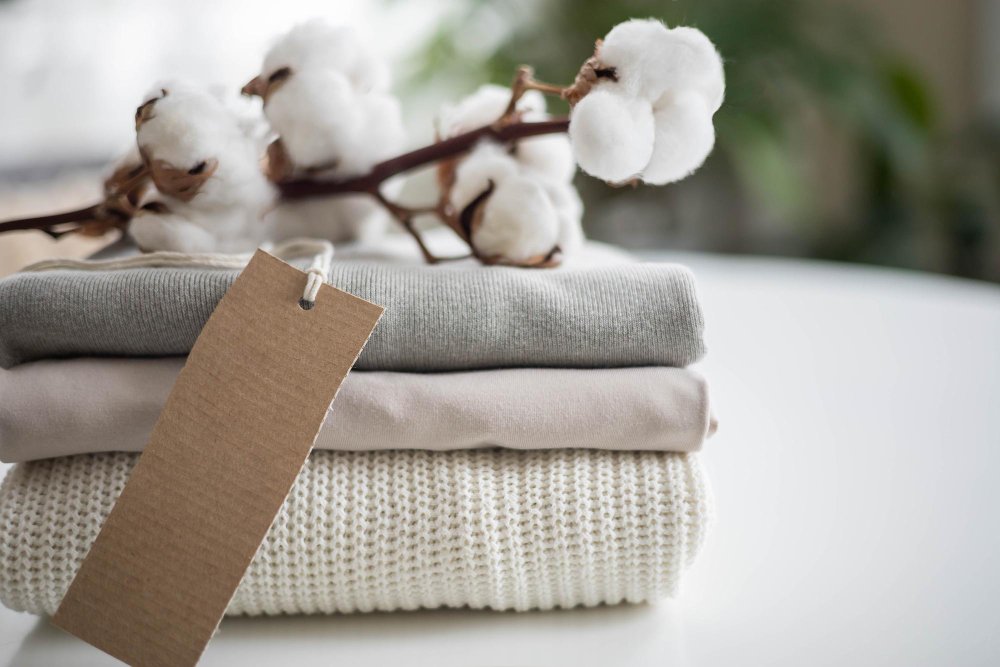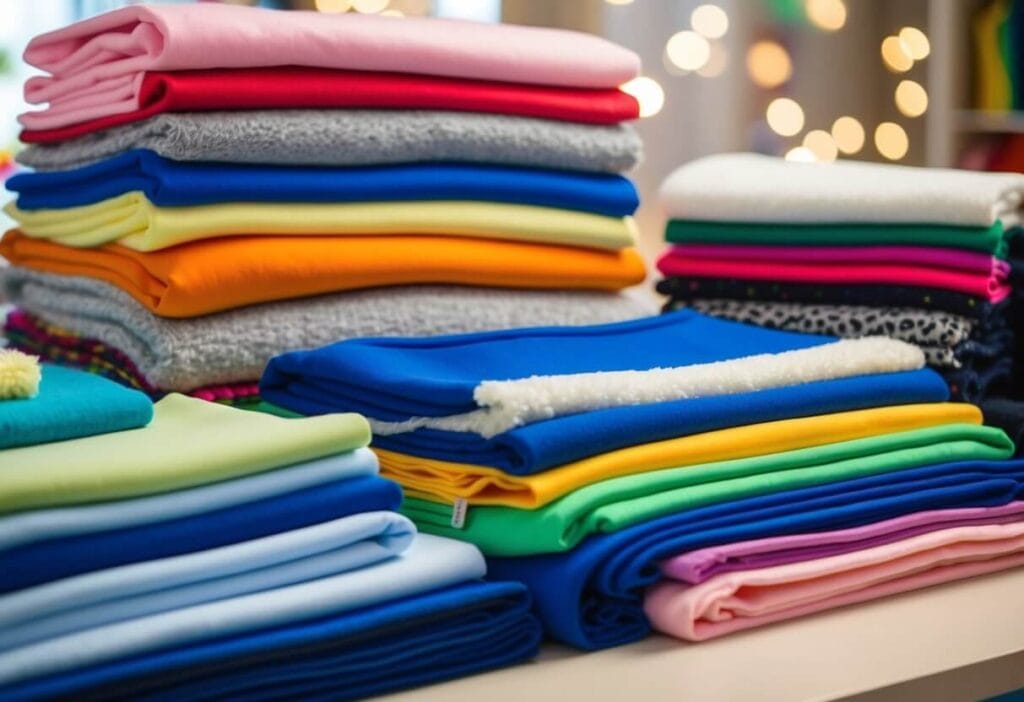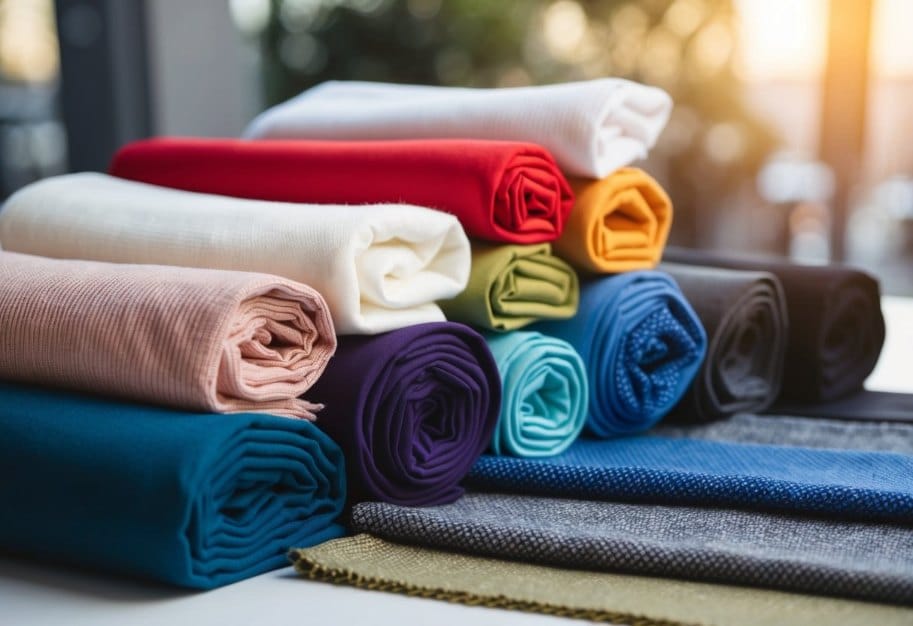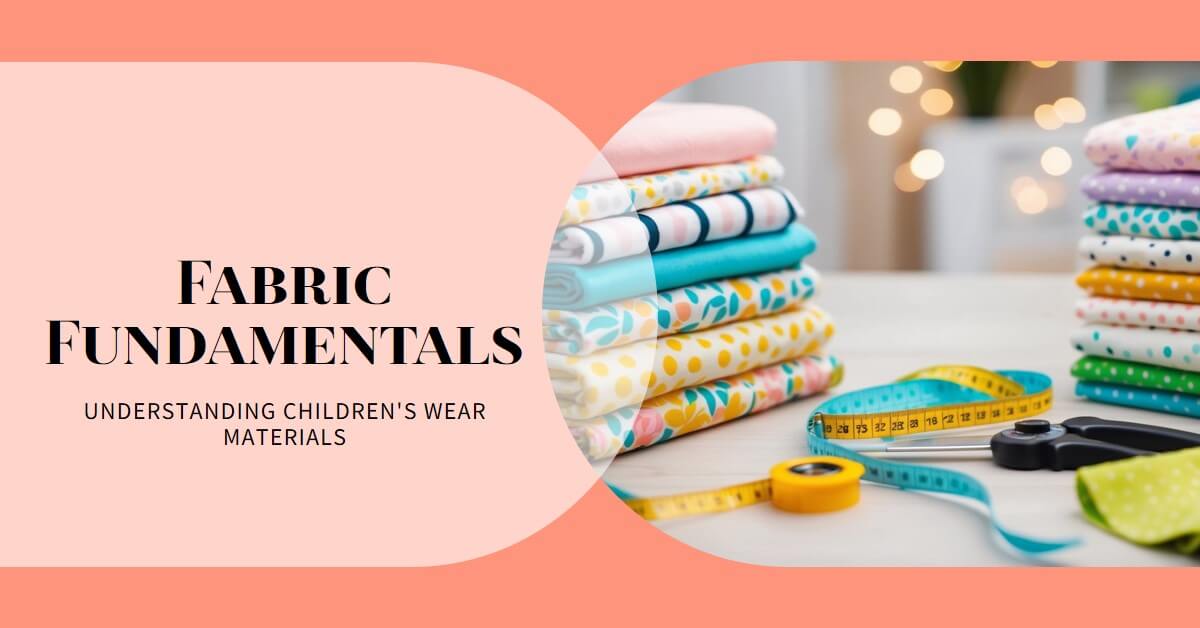Fabric Essential Guide for Parents
Choosing the right fabric for children’s clothing is crucial for their comfort and well-being. Kids have sensitive skin and active lifestyles, so their garments need to be soft, durable, and safe. Natural fibres like cotton are often ideal for children’s wear due to their breathability and gentle feel against the skin.
Fabric selection for kids’ clothes involves more than just picking pretty patterns. It’s about finding materials that can withstand frequent washing, resist stains, and move with a child’s energetic play. Some synthetic blends offer added stretch and easy care, while speciality fabrics provide extra warmth or water resistance for outerwear.
When shopping for children’s clothing, it’s wise to look at the fabric label. This small tag can tell you a lot about how the garment will perform and whether it’s suitable for your child’s needs. Pay attention to fabric weight, texture, and care instructions to ensure you’re making the best choice for your little one’s wardrobe.
On This Page
Key Takeaways
- Natural fibres like cotton are often best for children’s sensitive skin
- Fabric durability and ease of care are important for kids’ active lifestyles
- Reading fabric labels helps in selecting suitable clothing for children
Understanding Natural Fibres

Natural fibres offer comfort, breathability and sustainability for children’s clothing. These materials come from plants and animals, providing unique properties for different garment needs.
Cotton Varieties and Properties
Cotton is a popular choice for children’s wear. It’s soft, absorbent and gentle on sensitive skin. Different cotton varieties offer unique benefits:
- Pima cotton: Extra-long fibres create a silky feel and high durability
- Egyptian cotton: Known for its luxurious softness and strength
- Organic cotton: Grown without harmful chemicals, ideal for eco-conscious parents
Cotton breathes well, keeping children cool in warm weather. It’s easy to care for and can withstand frequent washing. However, cotton may wrinkle easily and shrink if not treated properly.
The Versatility of Wool
Wool is a natural insulator, keeping children warm in cold weather. It has several useful properties:
- Moisture-wicking: Pulls sweat away from the skin
- Odour-resistant: Naturally fights bacteria growth
- Hypoallergenic: Less likely to cause allergic reactions
Merino wool is especially soft and suitable for children with sensitive skin. Wool can be used in jumpers, coats, and even base layers for outdoor activities. It’s naturally flame-resistant, adding an extra safety feature to children’s clothing.
Linen and Hemp: Breathability and Strength
Linen and hemp are plant-based fibres known for their durability and breathability. They’re excellent choices for summer clothing.
Linen:
- Highly absorbent and quick-drying
- Gets softer with each wash
- Naturally antibacterial
Hemp:
- Stronger than cotton
- UV-resistant, protecting skin from sun damage
- Eco-friendly, requiring less water to grow
Both materials are hypoallergenic and suitable for children with skin sensitivities. They’re ideal for warm-weather clothing like shorts, dresses, and lightweight shirts.
Innovative Natural Materials
New natural fibres are emerging in children’s wear:
Bamboo:
- Incredibly soft and silky
- Highly absorbent and moisture-wicking
- Naturally antibacterial
Tencel (made from wood pulp):
- Smooth texture, gentle on skin
- Excellent moisture management
- Environmentally friendly production process
These materials blend comfort with sustainability, offering parents eco-friendly options for their children’s wardrobes. They’re often used in everyday wear, pyjamas, and underwear due to their softness and breathability.
Synthetic Fabrics and Blends

Synthetic fabrics offer unique properties for children’s clothing. They provide durability, easy care, and special features like moisture-wicking. Let’s explore some key synthetic materials used in childrenswear.
Polyester and Its Uses in Childrenswear
Polyester is a common synthetic fabric in kids’ clothes. It’s strong, wrinkle-resistant, and dries quickly. These traits make it great for active children.
Polyester often appears in:
- School uniforms
- Sports kits
- Swimwear
It wicks moisture away from the skin, keeping kids dry during play. Some brands now use recycled polyester to make eco-friendly clothes.
Polyester blends well with natural fibres. This creates fabrics that are comfy but still easy to care for.
Evaluating Fleece for Warmth and Comfort
Fleece is a soft, fuzzy fabric made from polyester. It’s warm, lightweight, and perfect for cold weather gear.
Key benefits of fleece for kids:
- Traps heat well
- Dries fast if it gets wet
- Doesn’t itch like some wools
Fleece is often used in:
- Jumpers and hoodies
- Jackets and coats
- Hats and scarves
It’s machine washable and holds its shape well. This makes it a top choice for busy parents.
Benefits of Blended Fabrics
Blended fabrics mix synthetic and natural fibres. This gives clothes the best of both worlds.
Common blends include:
- Cotton-polyester: Soft yet durable
- Spandex-cotton: Stretchy and comfy
Blends can:
- Reduce wrinkles
- Improve shape retention
- Add stretch for growing kids
These fabrics often cost less than pure natural fibres. They’re also easier to care for, saving time on laundry day.
Regenerated Fibres: Tencel and Lyocell
Tencel and Lyocell are eco-friendly synthetic fabrics. They’re made from wood pulp using a closed-loop process.
These fabrics offer:
- Softness similar to cotton
- Good moisture management
- Biodegradability
Tencel and Lyocell work well for:
- T-shirts and tops
- Dresses and skirts
- Soft trousers
They’re gentle on sensitive skin, making them great for babies and young children. These fabrics also resist wrinkling and keep their shape well.
Fabric Weaves and Knits

Fabric weaves and knits form the foundation of children’s clothing. They affect comfort, durability, and style. Different structures suit various needs and activities.
Exploring Cotton Weaves
Cotton weaves offer many options for kids’ clothes. Plain weave is simple and strong. It’s used in broadcloth and voile. Broadcloth is smooth and crisp, good for shirts and dresses. Voile is light and airy, perfect for summer outfits.
Twill weave creates diagonal lines. It’s used in denim and corduroy. These fabrics are tough and last long. Corduroy is soft and warm, great for trousers and jackets.
Cotton poplin has a fine ribbed texture. It’s crisp yet soft, ideal for smart clothes. Poplin resists wrinkles and holds shape well.
Knitted Fabric Varieties
Knit fabrics stretch and move with a child. They’re comfy and easy to wear. Jersey is a single knit fabric. It’s soft, light, and breathable. T-shirts and leggings often use jersey.
Interlock is a double knit. It’s thicker and more stable than jersey. Interlock works well for jumpers and cardigans. It keeps its shape and resists curling at the edges.
Rib knit is stretchy and clings to the body. It’s great for cuffs, neckbands, and fitted tops. Rib knit comes in various widths and patterns.
Specialty Fabrics and Children’s Apparel
Choosing the right fabrics for children’s clothing involves balancing comfort, durability, and style. Different age groups and activities require specific material properties to meet kids’ needs.
Selecting Materials for Infant Clothing
For babies, soft and gentle fabrics are key. Muslin is a top choice due to its breathability and lightweight feel. This fabric keeps infants cool and comfortable.
Batiste is another excellent option for baby clothes. Its fine weave makes it smooth against sensitive skin. Many parents prefer bamboo fabric for its natural softness and moisture-wicking properties.
Handkerchief linen is perfect for warm weather. It’s light, airy, and dries quickly. For colder months, velour provides warmth without bulk.
When shopping for infant wear, look for natural fibres. These are less likely to cause skin irritation. Always check clothing labels to ensure safety and comfort.
Choosing Fabrics for Active Kids
Older children need sturdy fabrics that can withstand play and frequent washing. Cotton blends are popular for everyday wear. They’re comfortable and easy to care for.
For sportswear, synthetic materials like polyester offer durability and moisture management. These fabrics help keep active kids dry during physical activities.
Fleece is great for outerwear. It’s warm, soft, and doesn’t easily lose its shape. This makes it ideal for jackets and jumpers.
Denim is a classic choice for trousers and jackets. It’s tough and can handle rough play. Look for stretchy denim for added comfort and mobility.
Considering Aesthetics: Patterns and Textures
Children’s clothing often features fun patterns and textures. Broderie anglaise adds a delicate, lacy touch to dresses and blouses. It’s especially lovely for special occasions.
Velvet brings a luxurious feel to formal wear. Its rich texture is perfect for holiday outfits or fancy events. For a similar but more casual look, try corduroy.
Printed cottons offer endless design possibilities. From cartoon characters to playful geometrics, these fabrics bring personality to kids’ wardrobes.
Textured knits, like waffle weaves, add interest to simple styles. They’re cosy and provide visual appeal without being too fussy.
Textile Sustainability and Environmental Impact
The fashion industry’s environmental impact is significant. Textile production contributes to 10% of global carbon dioxide emissions. This has led to a growing focus on sustainability in children’s wear.
Natural fabrics like organic cotton and bamboo are gaining popularity. These materials use fewer chemicals and water in production. They also biodegrade more easily than synthetic options.
Merino wool is another eco-friendly choice for kidswear. It’s renewable, biodegradable, and doesn’t require frequent washing. This helps reduce water usage and microplastic pollution.
Recycled polyester is becoming more common in children’s clothing. It gives new life to plastic bottles and reduces reliance on virgin materials. However, it still sheds microplastics when washed.
Sustainable textiles often cost more than conventional options. This can be a challenge for families on a budget. But these fabrics may last longer, offering better value over time.
When choosing children’s wear, consider:
- Durability
- Ease of care
- Environmental impact
- Comfort for the child
Balancing these factors can help parents make sustainable choices without breaking the bank.
Frequently Asked Questions
What are the points to consider in choosing fabric for children’s wear?
When selecting fabrics for children’s clothing, it’s important to focus on:
• Comfort: Choose fabrics that are soft, breathable, and gentle on sensitive skin.
• Durability: Kids are active, so the fabric needs to withstand wear and tear.
• Safety: Ensure the material is free from harmful chemicals or allergens.
• Ease of Care: Opt for fabrics that are machine washable and easy to maintain.
What are 4 guidelines for choosing children’s clothing?
Here are four key guidelines for choosing children’s clothing:
1. Size and Fit: Always check the size charts and opt for comfortable fits that allow room for growth.
2. Fabric: Select soft, breathable materials that won’t irritate the child’s skin.
3. Safety: Avoid clothing with small buttons or embellishments that could pose a choking hazard.
4. Practicality: Choose clothing that’s easy to put on, take off, and clean—especially important for babies and toddlers.
What material are kids’ clothes made of?
Common materials used in kids’ clothes include:
• Cotton (most common)
• Polyester (often blended with cotton for durability)
• Wool (for warmth in colder climates)
• Bamboo (for soft, eco-friendly options)
• Linen (for lightweight, breathable summer wear)
What are the basic requirements of children’s clothing?
Children’s clothing should meet these basic requirements:
• Comfort: The fabric should be soft and non-irritating.
• Safety: Free from choking hazards and harmful chemicals.
• Durability: Able to withstand frequent washing and rough play.
• Fit: Clothes should allow free movement and not be too tight.
What is the most common fabric used in children’s wear?
The most common fabric used in children’s wear is cotton, valued for its softness, breathability, and hypoallergenic properties. Cotton blends, such as cotton-polyester, are also popular for added durability and reduced wrinkling.
What are three criteria you would feel are important when choosing fabrics for a children’s wear line?
For a children’s wear line, the three most important criteria would be:
1. Comfort: The fabric must be soft, breathable, and non-irritating to the skin.
2. Durability: It should be able to endure regular washing and active play.
3. Safety: Free from harmful chemicals, dyes, and small parts that could pose a hazard.
Is 100% cotton good for kids?
Yes, 100% cotton is an excellent choice for kids. It is soft, breathable, and gentle on sensitive skin, making it a great option for everyday wear. Cotton is also highly absorbent, helping to keep kids comfortable.
Is viscose a good material for kids?
Viscose can be a good material for kids’ clothing because it is lightweight, soft, and has a silky feel. However, it’s not as durable as cotton or polyester and may require more delicate care, making it less practical for everyday use.
Is polyester okay for children?
Polyester is generally okay for children, especially when blended with other fabrics like cotton to improve softness and breathability. However, because it is a synthetic fabric, it may not be as breathable as natural fibres and could cause discomfort in hot weather.
What is the best fabric for kids’ leggings?
The best fabric for kids’ leggings is a cotton-elastane blend. This combination offers softness, breathability, and the necessary stretch for active kids. The elastane (also known as spandex) provides flexibility, while cotton ensures comfort.
Is organic cotton better for kids?
Yes, organic cotton is generally better for kids because it’s grown without the use of harmful pesticides or chemicals. It’s softer than conventional cotton and less likely to irritate sensitive skin, making it a great choice for babies and children.
Which cotton is best for kids?
Organic cotton is the best type of cotton for kids due to its chemical-free farming process, making it ideal for sensitive skin. In terms of weave, combed cotton or ring-spun cotton are great options as they are softer and more durable.
What three factors should be kept in mind when choosing a child’s outfit?
When choosing a child’s outfit, consider:
1. Comfort: Is the outfit soft, breathable, and non-restrictive?
2. Practicality: Is it easy to put on and take off? Can it withstand playtime?
3. Safety: Are there any small buttons, zips, or embellishments that could be a choking hazard?
How to choose children’s clothes?
When choosing children’s clothes:
1. Check the fabric: Opt for soft, natural materials like cotton or bamboo.
2. Look for safety features: Avoid items with drawstrings or small parts.
3. Pick the right size: Ensure the clothes fit well but leave room for growth.
4. Consider the season: Choose breathable fabrics for summer and warmer fabrics for winter.
Is elastane safe for babies?
Yes, elastane (also known as spandex) is generally safe for babies, especially when blended with cotton.
It provides flexibility and stretch without irritating the skin. However, it’s important to ensure that the elastane is used in small percentages and the clothing is free from harsh chemicals.

